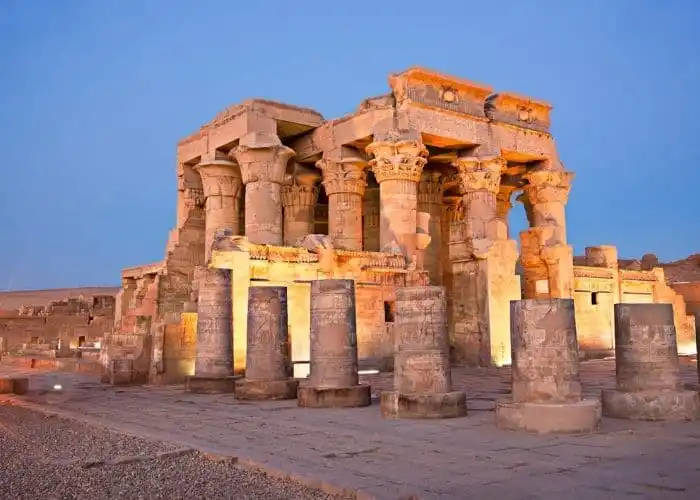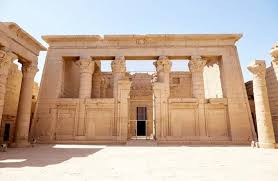Kom Ombo Temple stands as one of Egypt’s most distinctive religious monuments, renowned for its unusual dedication to two gods and its striking location overlooking the Nile River. This temple, rich in symbolism and architectural beauty, invites visitors to explore a fusion of myth, history, and art that defines its singular character in Egyptian heritage.
History of Construction
Construction of Kom Ombo Temple began during the reign of Ptolemy VI Philometor (180–145 BC), although the site itself hosted earlier temples dating back to Egypt’s New Kingdom. The temple’s decoration and expansion continued through the Roman period, lasting nearly 400 years, with significant contributions from rulers like Ptolemy XII and Roman emperors such as Tiberius and Domitian. This long span of construction reflects the temple’s evolving religious significance and architectural styles blending Egyptian and Greco-Roman traditions.
Location and Name Meaning
Situated approximately 45 kilometers north of Aswan, Kom Ombo Temple is uniquely perched on an elevated site overlooking the Nile’s east bank. The name “Kom Ombo” derives from an Arabic word “Kom” meaning “mound” or “hill,” and “Ombo,” from the ancient Egyptian “Noubt,” meaning “gold” — thus the name means “The Golden Mound.” This location was historically strategic and sacred, considered a gateway between Egypt and Nubia.
Why Was the Temple Built?
What sets Kom Ombo Temple apart is its dedication to two deities: Sobek, the crocodile god associated with fertility and water, and Horus the Elder (Haroeris), the falcon-headed god representing kingship and protection. The temple expresses this duality in its architecture by having two symmetrical sections, each devoted to one god, symbolizing the balance between chaos and order, nature and civilization.
Interior Layout of Kom Ombo Temple
The temple’s design is remarkable for having two parallel sanctuaries and sets of chambers, each mirrored for Sobek and Horus. Visitors first enter through a magnificent pylon leading to outer and inner halls with rows of columns adorned with hieroglyphs. The layout culminates in two sanctuaries, one for each god, flanked by chapels and rooms used for religious rituals and storage. The walls are decorated with detailed reliefs depicting rituals, royal ceremonies, and an extraordinary ancient calendar of festivals.
Fascinating Facts of Kom Ombo Temple
- The temple features rare carvings that include some of the earliest known depictions of surgical instruments, illustrating advanced medical knowledge of the ancient Egyptians.
- Sobek’s crocodile cult was significant here, and crocodile mummies have been found in nearby areas, emphasizing the god’s importance.
- The temple uniquely combines Egyptian religious architecture with Greco-Roman elements, reflecting cultural fusion during the Ptolemaic period.
Conclusion
Kom Ombo Temple remains an architectural and cultural gem, a testimony to Egypt’s spiritual depth and artistic brilliance. Its dual dedication and symbolic layout continue to fascinate historians, archaeologists, and visitors, making it a must-see site that bridges ancient beliefs with timeless beauty.




